By Editorial Staff
When Benjamin Franklin stepped off a boat in Philadelphia in 1723, he boasted no family support, no money, and no plan—only three loaves of bread, a restless mind, and an unshakable belief in his own potential. The seventeen-year-old runaway apprentice, weary and penniless, could hardly have imagined that he would one day help to draft the Declaration of Independence, charm kings and philosophers in Europe, and shape the moral and economic code of a new nation. Yet Franklin’s rise from poverty to prominence became the blueprint for what would later be called the American Dream—a belief that character [quality of being determined and able to deal with difficult situations], curiosity, and hard work could lift anyone, from any origin, to unbelievable greatness.
More than an inventor or a Founding Father, Franklin was a self-made visionary whose legacy fused ambition with virtue. He pioneered ideas that still define America: public libraries and volunteer fire brigades, civic philanthropy and entrepreneurial spirit, self-improvement and social progress. His story is not merely history—it constitutes the very origin of the belief that one person’s perseverance can shape a nation’s destiny.
From penniless immigrant to American icon
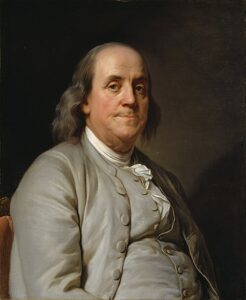
“Benjamin Franklin is often known more as one of the founding fathers in US history. Franklin is credited with creating bifocals, that whole Daylight Saving Time, and a smokeless coal stove. But Benjamin Franklin had a financially fragile upbringing before co-signing the Declaration of Independence. Franklin had to drop out of school at the age of ten to become an indentured servant to a printmaker.
Considering he was one of seventeen children (that’s a lot of mouths to feed), I find it incredible that a child with sixteen siblings who only attended two years of secondary schooling at Boston Latin School was able to write an autobiography, promote public health, and contribute in founding the US. (side note: while Franklin was pulled from formal school, he was able to continue reading, writing, and learning during his servitude in printmaking which kind of reinforces the importance of education in a weird way),” according to Meghan Werft through her 22 October 2015 story entitled “5 Influential People Who Faced Adversity Growing Up” published in Global Citizen.
Franklin, born in Boston on 17January 1706, rose from a modest upbringing to become one of the most influential figures in American history. A gifted printer, writer, and thinker, he founded the Pennsylvania Gazette and Poor Richard’s Almanack, and provided groundbreaking contributions to science, including experiments with electricity and inventions like the lightning rod.
Franklin played a key role in shaping the US nation’s future, helping to draft the Declaration of Independence and securing French support during the American Revolution. Beyond politics, he advanced public welfare through initiatives such as the first volunteer fire company, hospitals, and the University of Pennsylvania. Celebrated for his intellect, leadership, and civic vision, Franklin left a lasting legacy as a statesman, diplomat, and Founding Father of the United States.
American Battlefield Trust explains “Growing up, Franklin came from a modest family and was one of seventeen children. He began his formal education at eight when his father enrolled him in the Boston Latin School. While in school, Franklin showed strong leadership skills and was an avid reader and writer. Since his family could only afford Franklin’s education for two years, he dropped out and began working for his father at age ten.
At 15, Franklin’s older brother James accepted him as an apprentice at his print shop in Boston. Under James, Franklin began working for one of the first newspapers in America, The New England Courant. While working at the print shop, Franklin wrote under the pseudonym Silence Dogood. He became an advocate for free speech, despite his brother’s wishes. At age 17, Franklin ran away from his family to Philadelphia. In doing so, he broke his apprenticeship, making him a fugitive.”
The Goldwater Institute ran a story written by Timothy Sandefur, entitled “The Immortality of Ben Franklin and the American Dream Made Real” on 6 October 2023. Sandefur starts the story, saying “We don’t often think of Benjamin Franklin as an immigrant—but he was. In fact, he’s one of the great American immigration stories—and today marks the 300th anniversary of the day he arrived, penniless and alone, in his adopted hometown of Philadelphia.

He was born to a poor family in the colony of Massachusetts. His father was an English immigrant named Josiah Franklin, who worked as a candle and soap maker, and Benjamin was one of his sixteen children. He was given only a rudimentary education before being set to work as an apprentice, at the age of twelve, for his brother James, who ran a print shop in Boston. But James was physically abusive, and young Ben decided to run away.”
Sandefur points out that Franklin’s flight was a leap into danger and uncertainty—he risked arrest, hunger, and destitution for a mere chance to shape his own destiny. “That was illegal. Under the apprenticeship system in place at the time, an apprentice who ran away before his term of service was up was breaking the law—and runaways could be arrested, jailed, and even forced to serve extra time working for their masters. Nevertheless, at the age of 17, Ben broke the law by fleeing Massachusetts for Pennsylvania, where he arrived by boat on October 6, 1723.”
Pennsylvania actually seemed like the perfect place for Franklin. “Pennsylvania wasn’t just 300 miles away from Boston—the Quaker City was also far more tolerant and cosmopolitan: it was destined to become the intellectual capital of the American colonies, thanks in no small part to Franklin’s influence.”
In Franklin’s famous Autobiography, Franklin vividly recounts extreme hardships he faced when he first set foot on the shores of the New World— a narrative that reinforces just how profound his suffering truly was. “I was dirty from my journey; my pockets were stuffed out with shirts and stockings, and I knew no soul nor where to look for lodging. I was fatigued with traveling, rowing, and want of rest, I was very hungry; and my whole stock of cash consisted of a Dutch dollar….
I walked up the street, gazing about till near the market-house I met a boy with bread. I had made many a meal on bread, and, inquiring where he got it, I went immediately to the baker’s he directed me to, in Second Street, and asked for biscuit, intending such as we had in Boston; but they, it seems, were not made in Philadelphia.”
He adds “Then I asked for a three-penny loaf, and was told they had none such. So not considering or knowing the difference of money, and the greater cheapness nor the names of his bread, I bade him give me three-penny worth of any sort. He gave me, accordingly, three great puffy rolls. I was surprised at the quantity, but took it, and, having no room in my pockets, walked off with a roll under each arm, and eating the other. Thus I went up Market Street…. I made…a most awkward, ridiculous appearance.”
Nevertheless, according to Sandefur, Franklin has managed to adapt successfully to the new setting and created a catalogue of virtues. The latter ones form a personal set of moral guidelines he carefully followed throughout his life; which has shaped not only his character but also his approach to business, community service, and civic leadership.

Sandefur explains “Franklin was able to find work in a print shop, and through hard work and what we now call ‘networking,’ was able to build a reputation for himself. Eventually, he became one of the most famous writers and publishers in the American colonies. Along with his financial success, he also helped lead a wide variety of community projects—co-founding America’s first lending library, first hospital, first home insurance company, first volunteer fire department, and the country’s most prestigious intellectual institution, the American Philosophical Society.
He invented bifocals and the Franklin Stove. His experiments with electricity, which climaxed with the invention of the lightning rod, made him a world hero—and all of this was before he became an important patriot leader. He was celebrated as ‘Doctor’ Franklin—but he had barely any formal education at all. As a signer of the Declaration of Independence and the Constitution, Ben Franklin will always be regarded as among the greatest of statesmen, but he was also America’s first entrepreneurial hero.”
On the latter point, Sandefur clarifies “His Autobiography, published after his death, became a classic among business leaders throughout the nineteenth century, and he remains one of the most popular heroes among entrepreneurs today. His book offered helpful advice on how to be a successful businessman (for example, he urged entrepreneurs to make sure that people see how busy you are)—but it also examined the virtues of entrepreneurship: the moral values that go into making a person a successful and prosperous business leader. He related how he created a catalogue of virtues.”
Sandefur explains that Franklin didn’t leave his success to chance—he carefully charted a personal roadmap for virtue, capturing the principles that would guide every aspect of his life. “I included under thirteen names of virtues all that at that time occurred to me as necessary or desirable, and annexed to each a short precept, which fully expressed the extent I gave to its meaning. These names of virtues, with their precepts, were: 1. Temperance – eat not to dullness; drink not to elevation. 2. Silence – speak not but what may benefit others or yourself; avoid trifling conversation.3. Order – let all your things have their places; let each part of your business have its time. 4. Resolution – resolve to perform what you ought; perform without fail what you resolve. 5. Frugality – make no expense but to do good to others or yourself; i.e., waste nothing. 6. Industry – lose no time; be always employed in something useful; cut off all unnecessary actions.
7. Sincerity – use no hurtful deceit; think innocently and justly; and, if you speak, speak accordingly. 8. Justice – wrong none by doing injuries, or omitting the benefits that are your duty. 9. Moderation – avoid extremes; forbear resenting injuries so much as you think they deserve. 10. Cleanliness – tolerate no uncleanliness in body, clothes, or habitation. 11. Tranquility – be not disturbed at trifles, or at accidents common or unavoidable. 12. Chastity – rarely use venery but for health or offspring; never to dullness, weakness, or the Injury of your own or another’s peace or reputation. 13. Humility – imitate Jesus and Socrates.”
Sandefur emphasizes “This is an interesting list, because it’s not the list that the heroes of, say, ancient Greek mythology would have written. There’s nothing here about conquering enemies or subduing the powerful. In The Aeneid, Virgil described Rome’s mission like this: ‘to spare the defeated, break the proud in war.’ Franklin’s list is nothing like that. It’s a list of what the economic scholar Dierdre McCloskey calls ‘the bourgeois virtues’—industry, frugality, moderation. These are the virtues of the respectable businessman and responsible citizen. And they’re the moral building blocks of what we today call the American Dream.”
Sandefur additionally underscores Franklin’s belief that America’s greatness rested not on privilege or pedigree, but on the power of people’s ability to work and contribute—a conviction Franklin later captured in his spirited advice to Europeans considering immigration. “‘[In] America, Franklin later wrote, in an article of advice to Europeans considering immigrating, ‘people do not inquire concerning a stranger, What is he? But What can he do…? In short America is the Land of Labor, and by no means what the English call Lubberland…where the Streets are said to be paved with half-peck loaves, the houses tiled with pancakes, and where the fowls fly about ready roasted, crying, Come eat me!’
Hard work and devotion would be rewarded, and peace and diversity would prevail, Franklin thought, because America was a land of businesspeople and entrepreneurs. Ben Franklin’s arrival in Philadelphia in October 1723—with nothing to his name but his willingness to work—is the kind of story that would be played out for centuries to come in places like Ellis Island. And his rise to economic success and national immortality would prove only one of countless similar stories of the American Dream made real.”
Benjamin Franklin: the printer who orchestrated a revolution
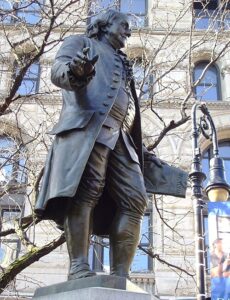
American Battlefield Trust writes “While in Philadelphia, Franklin found work as a printer and began making connections, including meeting his future wife, Deborah Reed. Franklin sailed to London, England, a year later and began working as a typesetter in a print shop. He returned in 1726 and opened his own print shop in Philadelphia, where he published a newspaper called the Pennsylvania Gazette and the ‘Poor Richard’s Almanack.’ While in Philadelphia, Franklin created the first volunteer firefighting company and became involved with public affairs.
In 1743, he founded the American Philosophical Society and began researching electricity. During his lifetime, Franklin continued to study science, including oceanography, engineering, meteorology, and physics. While studying, he created experiments, including the kite experiment, and invent products like the lighting rod based on his research. In addition to science, Franklin was interested in education and caring for society. Due to his wealth, Franklin organized the Pennsylvania militia and founded the first hospital in the colonies.”
As Franklin’s reputation as a civic innovator grew, so did his influence in determining the destiny of both Philadelphia and the emerging nation, according to American Battlefield Trust. “Under Franklin’s influence, the city streets were clean, and colonists in Philadelphia had homeowners’ insurance. Franklin’s popularity grew when he aided in founding the Academy of Philadelphia, later known as the University of Pennsylvania. Since the French and Indian War, Franklin supported the American cause. In 1754, during the Albany Congress, he used the press to circulate the famous ‘Join or Die’ cartoon in an attempt for the colonies to rally against the French.
While at the congress, Franklin proposed the Albany Plan, which failed then but later inspired the Articles of Confederation and a uniting of the colonies. As tensions rose in the colonies, the Franklin press continued to publish pro-independence articles and stories. In 1751, Franklin was elected to represent the Pennsylvania assembly in the British parliament in London. He made connections in England with parliament officials and worked to settle disputes between the colonies and Britain. Franklin temporarily returned home until he was sent back to London in 1765 to testify against the Stamp Act. During Franklin’s second mission to England in 1775, the British fired upon colonists at Lexington and Concord, officially beginning the American Revolution.”
With the first shots of the American Revolution echoing across the Atlantic, Franklin knew that his place was no longer in London but among his fellow colonists fighting for liberty. As soon as the thunder of revolution broke out, and that the word reached Franklin, he instantaneously returned home. American Battlefield Trust explains “Upon hearing the news, Franklin returned to the colonies. He arrived in Philadelphia in May of 1775, and the Pennsylvania Assembly elected Franklin to the Second Continental Congress. The congress met to discuss the revolution’s goals and plan the next steps for the colonies. While serving as a delegate for Pennsylvania, Franklin served as the United States’ first postmaster general, suffered from gout, and missed most of the delegations.
In early 1776, he was elected to the ‘Committee of Five,’ alongside Thomas Jefferson, John Adams, Robert Livingston, and Rodger Sherman was assigned to write the Declaration of Independence. Although Thomas Jefferson wrote most of the declaration, Franklin made ‘small but important changes.’ On July 4, the Declaration of Independence was signed, and the colonies readied to take the next step toward independence. In October 1776, Franklin was assigned the duty of Ambassador to France. To beat the British, the colonist needed European aid, and it was Franklin’s mission to convince France to help the United States.”
In France, Franklin worked industriously and successfully. “While in France, Franklin made connections with French politicians and the monarchy. France was willing to aid the colonies but needed proof that the American Revolution was not a lost cause. In October 1777, the Continental Army won a significant victory over the British during the Battle of Saratoga, forcing a British army to surrender. The battle showed that the United States had the potential to win and the French to sign the 1778 Alliance Treaty, solidifying the Franco-American alliance.
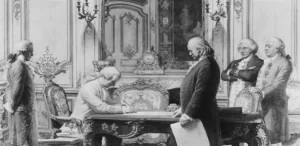
February 6, 1778. This 1778 treaty established the formal alliance of America with France during the American Revolutionary War. Library of Congress,”—American Battlefield Trust. Although American Battlefield Trust does not specify it, this photograph likely depicts the signing of the treaty.
French troops arrived in the colonies under the command of Jean-Baptiste, Comte de Rochambeau. The Continental and the French army worked together and were victorious during the Battle of Yorktown. In 1783, Franklin aided in the surrender under the Treaty of Paris. He remained in France for another two years, continuing to serve as the American minister for France and Sweden,” says American Battlefield Trust.
The same source further states that as the newly independent United States sought to define its identity and governance, one of its most revered founding figures returned home to lend his wisdom once more. Having spent years abroad shaping diplomatic ties and securing American independence, Franklin’s final years were marked by a deep commitment to building the nation’s constitutional foundation. It was during this crucial moment in history that “In 1785, Franklin returned to the United States and was immediately assigned to represent Pennsylvania in the Constitutional Convention. At age 81, Franklin was the oldest representative at the convention. As a supporter of the United States Constitution, Franklin urged his fellow delegates to support the document.
The Constitution was ratified in 1788, and the following year George Washington was selected as the United States’ first President. On April 17, 1790, Franklin died in his Philadelphia home. Over 20,000 people attended his funeral in Pennsylvania to celebrate his life, accomplishments, and impact on the founding of the United States.”
As already said, despite being an influential US Founding Father, Franklin never became president mainly probably due to timing, age and illness. By the time the U.S. Constitution was adopted in 1788 and the first presidential election was held in 1789, Franklin was 81 years old—considered too old to occupy such a demanding role at the time. George Washington was then unanimously elected the first president, receiving all 69 electoral votes cast by participating states. It signifies that a total of 69 electors voted for Washington. These electors had been designated by the participating states—since not all the states participated in the election, only 10 of the 13 states did.
The 13 states were the initial states that composed the United States of America after declaring independence from Great Britain. They were the former British colonies which ratified the U.S. Constitution, but not all of them did so immediately. Those which took part in the election were those which had validated the Constitution.
History Extra—the official website for BBC History Magazine, in its 25 April 2025 story headlined “Benjamin Franklin: the Founding Father who saved America” — explains “He was the only person to sign the four seminal documents in American fight for independence. Those documents were the Declaration of Independence, the Franco-American Alliance, the Treaty of Paris, and the Constitution.
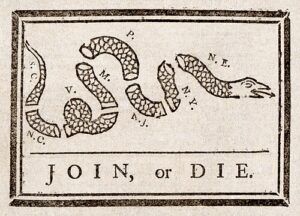
He was one of the first political cartoonists. In 1754, Franklin drew a cartoon for the Pennsylvania Gazette entitled ‘Join, or Die’ to call upon the colonies to unite, depicting them as a snake split into sections. This is now credited as the earliest-known political cartoon in America.”
This website adds “The year after Washington became the first US president, Franklin died on 17 April 1790 at the age of 84. He had struggled with his weight for a long time, which had caused health issues including gout, and he finally succumbed due to complications from an attack of pleurisy.
Reportedly, Franklin’s last words, in response to his daughter asking if he wanted to change position in bed, were ‘A dying men can do nothing easy.’ Tens of thousands attended his funeral in Philadelphia, while the French National Assembly went into a state of mourning. Of all the accolades and honours that could have been written on his grave, in acknowledgement of the many achievements and deeds of one of the most significant figures of the 18th century, his final resting place is marked only by the words: ‘Benjamin and Deborah Franklin, 1790’.”
Franklin’s kindness and fundraising technique still used today
Franklin’s unbelievable success isn’t confined to politics, science, or diplomacy—it extends deeply into the realm of generosity and social innovation. His pioneering spirit in philanthropy and community building has laid the foundation for charitable practices that still define modern fundraising and mutual aid today.
Tennessee Nonprofit Network (TNN) has released a piece of writing, entitled “Nonprofit History Crash Course: Ben Franklin’s Rarely-Discussed Innovations in Philanthropy”, and written by Dr. Kevin Dean, TNN President and CEO.
“We know Benjamin Franklin as a Founding Father, a signer of the Declaration of Independence, a brilliant inventor who harnessed electricity, and a wise statesman who helped shape the nascent American nation. Yet, often overlooked in the chronicles of his remarkable life is his profound commitment to philanthropy. Franklin wasn’t just a man of science and politics; he was a man of deep benevolence, driven by a fervent belief in the power of collective action to improve society. His innovative approaches to charitable giving and community building left an enduring legacy, shaping the landscape of philanthropy in America and beyond.”
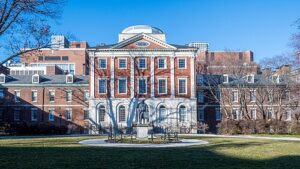
According to Dr. Dean, Franklin was the creator of the matching gift. “One of Franklin’s most significant contributions to philanthropy was his pioneering use of the ‘matching gift’ as a fundraising tool. In the 1750s, Dr. Thomas Bond approached Franklin with a vision to establish Pennsylvania Hospital, the first hospital in the American colonies. Recognizing the immense value of such an institution, Franklin threw his weight behind the project, but he faced a significant hurdle: securing sufficient funds.
To overcome this challenge, Franklin devised a brilliant strategy. He petitioned the Pennsylvania Assembly for a grant, promising that he and his fellow citizens would match the government’s contribution pound for pound. This innovative approach, leveraging private funds to unlock public support, proved remarkably successful. The Assembly agreed to the challenge, and Franklin, with his characteristic zeal, rallied the community to raise the matching funds. This marked the birth of the matching gift, a fundraising technique that continues to be widely employed by charitable organizations today.”
Long before modern hospitals and charitable foundations became fixtures of civic life, Franklin envisioned a society where public welfare and private initiative worked hand in hand. His efforts in founding Pennsylvania Hospital exemplify this vision, demonstrating how one individual’s commitment to community could transform societal infrastructure and inspire future models of civic engagement. Dr. Dean explains “The establishment of Pennsylvania Hospital was a landmark achievement, not just for its role in providing much-needed medical care but also for its embodiment of Franklin’s philanthropic philosophy.
He believed in the power of public-private partnerships to address societal needs, a belief reflected in his tireless efforts to secure both government funding and private donations for the hospital. This approach, which he would later apply to other projects such as libraries and fire companies, laid the groundwork for the modern concept of ‘civic venture philanthropy,’ where private citizens and government collaborate to tackle social challenges.”
Dr. underlines that Franklin was the Father of mutual aid and libraries for all. “Beyond his fundraising prowess, Franklin was also a pioneer in the realm of mutual aid. In 1736, he founded the Union Fire Company, Philadelphia’s first volunteer fire brigade. This initiative stemmed from his deep concern for public safety, having witnessed firsthand the devastating consequences of uncontrolled fires. The Union Fire Company, and the numerous others that followed its model, were not merely firefighting units; they were early examples of mutual benefit societies, organizations formed to provide members with collective support in times of need.
This concept of shared responsibility and collective action, deeply ingrained in Franklin’s philosophy, would later inspire the development of various mutual aid societies and fraternal organizations across the United States. Franklin’s commitment to community well-being extended far beyond fire safety. He was instrumental in the establishment of the Library Company of Philadelphia in 1731, America’s first lending library,” says Dr. Dean before adding “Recognizing the importance of knowledge and education for individual and societal progress, Franklin envisioned a library that would be accessible to all, regardless of their social standing.

This vision was a radical departure from the elitist libraries of the time, which were typically reserved for the wealthy and learned. The Library Company, funded by subscriptions from its members, became a cornerstone of Philadelphia’s intellectual life, fostering a culture of learning and self-improvement.”
Dr. Dean affirms that Franklin was a kind and generous man and the framer of charitable giving. “Franklin’s philanthropic endeavors were not confined to grand institutions and formal organizations. He was a firm believer in the importance of individual acts of kindness and generosity. Throughout his life, he supported numerous charitable causes, often anonymously, donating to schools, churches, and individuals in need. He also used his considerable influence to advocate for social reforms, such as the abolition of slavery and the improvement of prison conditions. His belief in the inherent dignity of all human beings, regardless of their race or social status, informed his philanthropic work and his broader vision for a just and equitable society.
One of Franklin’s lesser-known but equally significant contributions to philanthropy was his role in shaping the legal framework for charitable giving in America. In 1787, while serving as a delegate to the Constitutional Convention, he successfully advocated for the inclusion of a clause in the Constitution that protected the right of individuals to form associations for charitable purposes. This clause, enshrined in the First Amendment, laid the legal foundation for the non-profit sector in the United States, ensuring that citizens would have the freedom to organize and contribute to causes they believed in.”
Dr. Dean underscores “Franklin’s legacy extends far beyond the specific institutions and organizations he helped establish. His innovative approaches to fundraising and his emphasis on public-private partnerships have had a profound and lasting impact on the field of philanthropy. His example inspired generations of Americans to engage in charitable giving and community building, shaping a culture of generosity and civic responsibility that continues to this day.”
Let’s pause, to reflect
While this piece may appear lengthy at first glance, Life In Humanity can confidently argue that, proportionally. It is extraordinarily brief compared to the immense role Benjamin Franklin played in shaping not only the United States but also the very ideals of civic responsibility and philanthropy. From a penniless runaway to a statesman, inventor, and pioneer of public-private partnerships, Franklin’s life illustrates that no origin is too humble, no challenge insurmountable, and no ambition unattainable.
This article reinforces a principle Life In Humanity has long championed: that individuals, regardless of where they come from, can climb ladders of immeasurable success through perseverance, vision, and an unswerving commitment to their goal. Franklin’s story acts as a testament to human potential, reminding us that the bounds of achievement are limited only by one’s courage to act and innovate.